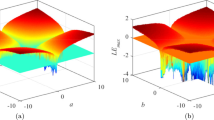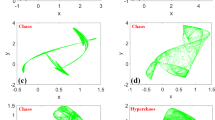Abstract
In this paper, a class of hyperchaotic mappings is constructed based on one-dimensional Logistic map and modulated coupling control methods. First, the equilibrium points of the system are analyzed using the M-SS map as an example and it is found that the M-SS map has infinite equilibrium points. Second, the dynamical characteristics of the newly constructed hyperchaotic maps are analyzed by means of phase diagram, bifurcation diagram, Lyapunov exponent spectrums and complexity. The analysis shows that the newly constructed class of hyperchaotic mappings has richer dynamical properties than the one-dimensional Logistic map, such as wider chaotic domains, hyperchaotic states and higher complexity. In addition, the DSP implementation of the hyperchaotic maps illustrates the feasibility of the class of chaotic maps in digital circuits.


















Similar content being viewed by others
References
B. R. Hunt, T.Y. Li, J.A. Kennedy, H.E. Nusse, Period Three Implies Chaos, vol. 6, no Chapter (Springer, New York, 2004), pp. 77–84. https://doi.org/10.1007/978-0-387-21830-4
C. Sparrow, The Lorenz equations: bifurcations, chaos, and strange attractors. Appl. Math. Sci. 41(1), 106–110 (1982)
J.B. Mclaughlin, Period-doubling bifurcations and chaotic motion for a parametrically forced pendulum. J. Statal Phys. 24(2), 375–388 (1981)
M.V. Torbett, Chaotic motion in a comet disk beyond Neptune—the delivery of short-period comets. Astron. J. 98(4), 1477–1481 (1989)
Q. Chen, L. Huang, Y.C. Lai, C. Grebogi, D. Dietz, Extensively chaotic motion in electrostatically driven nanowires and applications. Nano Lett. 10(2), 406–413 (2010)
L. Xuejun, J. Mou, Y. Cao, S. Banerjee, An optical image encryption algorithm based on a fractional-order laser hyperchaotic system. Int. J. Bifurc. Chaos 32, 03/15 (2022). https://doi.org/10.1142/S0218127422500353
S. Vaidyanathan, A.T. Azar, Analysis, control and synchronization of a nine-term 3-D novel chaotic system. Kyungpook Math.J. 55(3), 563–586 (2015)
J. Lu, X. Wu, J. Lü, Synchronization of a unified chaotic system and the application in secure communication. Phys. Lett. A 305(6), 365–370 (2002)
X. Gao, J. Mou, S. Banerjee, Y. Cao, L. Xiong, X. Chen, An effective multiple-image encryption algorithm based on 3D cube and hyperchaotic map. J. King Saud Univ. Comput. Inf. Sci. 34(4), 1535–1551 (2022). https://doi.org/10.1016/j.jksuci.2022.01.017
S. Strogatz, A. Edwards, Sync-how order emerges from chaos in the universe, nature, and daily life. Math. Intell. 27(1), 89–89 (2005)
M. Kyriazis, Practical applications of chaos theory to the modulation of human ageing: nature prefers chaos to regularity. Biogerontology 4(2), 75–90 (2003)
R.P. Taylor, Science and art: emergence of patterns from nature’s chaos, through parallels between Edward Lorenz and Yves Klein. Nonlinear Dyn. Psychol. Life Sci. 13(3), 341–348 (2009)
C. Li, G. Peng, Chaos in Chen’s system with a fractional order. Chaos Solitons Fractals 22(2), 443–450 (2004)
H.N. Agiza, Chaos synchronization of Lü dynamical system. Nonlinear Anal. 58(1–2), 11–20 (2004)
C. Ma, J. Mou, L. Xiong, S. Banerjee, X. Han, Dynamical analysis of a new chaotic system: asymmetric multistability, offset boosting control and circuit realization. Nonlinear Dyn, 103(3), 2867–2880 (2021)
T. Liu, J. Yu, H. Yan, J. Mou, A fractional-order chaotic system with infinite attractor coexistence and its DSP implementation. IEEE Access 8, 199852–199863 (2020)
L.-L. Huang, S. Liu, J.-H. Xiang, A.L.-Y. Wang, Design and multistability analysis of five-value memristor-based chaotic system with hidden attractors. Chin. Phys. B 30(10), 100506–100506 (2021)
A.P. Veselov, Integrable discrete-time systems and difference operators. Funct. Anal. Appl. 22(2), 83–93 (1988)
Y. Zhang, H. Gong, J. Li, B. Qiu, M. Yang, Discrete time-varying four fundamental operations implemented by Euler forward difference, pp. 9807-9812 (2017)
I. Talbi et al., Different dimensional fractional-order discrete chaotic systems based on the Caputo h-difference discrete operator: dynamics, control, and synchronization. Adv. Differ. Equ. 2020(1), 1–15 (2020)
C.F. Feng, H.J. Yang, Projective-lag synchronization scheme between two different discrete-time chaotic systems. Int. J. Non-Linear Mech. 121, 103451 (2020)
S. Dai, K. Sun, W. Ai, Y. Peng, Novel discrete chaotic system via fractal transformation and its DSP implementation. Modern Phys. Lett. B 34(Supp01), 2050429 (2020)
T. Liu, S. Banerjee, H. Yan, J. Mou, Dynamical analysis of the improper fractional-order 2D-SCLMM and its DSP implementation. Eur. Phys. J. Plus 136(5), 1–17 (2021)
C. Ma, J. Mou, P. Li, T. Liu, Dynamic analysis of a new two-dimensional map in three forms: integer-order, fractional-order and improper fractional-order. Eur. Phys. J. Spec. Top. 203(7), 1945–1957 (2021)
S. Bendoukha, Stabilization and Synchronization of Discrete-time Fractional Chaotic Systems with Non-identical Dimensions. Acta Mathematicae Applicatae Sinica (English Series) 37(3), 16 (2021)
M. Long, L.L. Wang, S-box design based on discrete chaotic map and improved artificial bee colony algorithm. IEEE Access PP(99), 1–1 (2021)
X. Ma, J. Mou, J. Liu, C. Ma, F. Yang, X. Zhao, A novel simple chaotic circuit based on memristor-memcapacitor. Nonlinear Dyn. 100(3), 2859–2876 (2020). https://doi.org/10.1007/s11071-020-05601-x
C. Qin, K. Sun, S. He, Characteristic analysis of fractional-order memristor-based hypogenetic jerk system and its DSP implementation. Electronics 10(7), 841 (2021)
Q. Zhang, G. Chen, L. Wan, Exponential synchronization of discrete-time impulsive dynamical networks with time-varying delays and stochastic disturbances. Neurocomputing 309(OCT.2), 62–69 (2018)
G. Chen, Y. Shi, Introduction to anti-control of discrete chaos: theory and applications. Philos. Trans. R. Soc. Math. Phys. Eng. Sci. 364(1846), 2433–2447 (2006)
L. Chen, Y. Hao, T. Huang, L. Yuan, L. Yin, Chaos in fractional-order discrete neural networks with application to image encryption. Neural Netw. 125, 174–184 (2020)
C. Chen, K. Sun, Q. Xu, A color image encryption algorithm based on 2D-CIMM chaotic map. China Commun. 17(5), 9 (2020)
X. Gao, J. Mou, L. Xiong, Y. Sha, H. Yan, Y. Cao, A fast and efficient multiple images encryption based on single channel encryption and chaotic system. Nonlinear Dyn. (2022). https://doi.org/10.1007/s11071-021-07192-7
C. Dong, K. Sun, S. He, H. Wang, A hyperchaotic cycloid map with attractor topology sensitive to system parameters. Chaos Interdiscip. J. Nonlinear Sci. 31(8), 083132 (2021). https://doi.org/10.1063/5.0061519
Z. Canyan, Z. Lihua, Y. Wang, L. Jiasheng, L.-F. Mao, Periodic performance of the chaotic spreadspectrum sequence on finite precision * * This project was supported by the National Natural Science Foundation of China (60572075) and the Natural Science Researching Project for Jiangsu Universities (05KJD510177). J. Syst. Eng. Electron. 19, 672–678 (2008)
D. He, C. He, L.G. Jiang, H.W. Zhu, G.R. Hu, Chaotic characteristics of a one-dimensional iterative map with infinite collapses. IEEE Trans. Circuits Syst. Part I Fundam. Theory Appl. 900–906 (2001)
Y. Peng, S. He, K. Sun, Chaos in the discrete memristor-based system with fractional-order difference, Results Phys. 104106, (2021)
H. Natiq, S. Banerjee, M.R.M. Said, Cosine chaotification technique to enhance chaos and complexity of discrete systems. Eur. Phys. J. Spec. Top. 228(1), 185–194 (2019). https://doi.org/10.1140/epjst/e2019-800206-9
N.K. Pareek, V. Patidar, K.K. Sud, Image encryption using chaotic logistic map. Image Vis. Comput. 24(9), 926–934 (2006)
S. Borislav, K. Krasimir, Novel image encryption scheme based on Chebyshev polynomial and duffing map. Sci. World J. 2014, 283639 (2014)
C. Li, L.Y. Zhang, R. Ou, K.-W. Wong, S. Shu, Breaking a novel colour image encryption algorithm based on chaos. Nonlinear Dyn. 70(4), 2383–2388 (2012). https://doi.org/10.1007/s11071-012-0626-5
F. Yuan, Y. Deng, Y. Li, G. Chen, A cascading method for constructing new discrete chaotic systems with better randomness. Chaos 29(5), 053120 (2019)
Y. Li, W.K.S. Tang, G. Chen, Generating hyperchaos via state feedback control. Int. J. Bifurc. Chaos 15(10), 3367–3375 (2005)
C. Wu, K. Sun, Y. Xiao, A hyperchaotic map with multi-elliptic cavities based on modulation and coupling. Eur. Phys. J. Spec. Top. 230(7), 2011–2020 (2021). https://doi.org/10.1140/epjs/s11734-021-00126-9
S. Zhang, J.H. Zheng, X. Wang, Z. Zeng, A novel no-equilibrium HR neuron model with hidden homogeneous extreme multistability. Chaos Solitons Fractals 145(4), 110761 (2021)
Acknowledgements
This work was supported by the National Natural Science Foundation of China (Grant Nos. 62061014); The Natural Science Foundation of Liaoning Province (2020-MS-274); The Basic Scientific Research Projects of Colleges and Universities of Liaoning Province (Grant Nos. LJKZ0545).
Author information
Authors and Affiliations
Contributions
Xintong Han designed and carried out experiments, data analyzed and manuscript wrote. Jun Mou and Hadi Jahanshahi made the theoretical guidance for this paper. Yinghong Cao and Fanling Bu improved the algorithm. All authors reviewed the manuscript.
Corresponding authors
Ethics declarations
Conflict of interest
No conflicts of interests about the publication by all authors.
Rights and permissions
About this article
Cite this article
Han, X., Mou, J., Jahanshahi, H. et al. A new set of hyperchaotic maps based on modulation and coupling. Eur. Phys. J. Plus 137, 523 (2022). https://doi.org/10.1140/epjp/s13360-022-02734-3
Received:
Accepted:
Published:
DOI: https://doi.org/10.1140/epjp/s13360-022-02734-3




